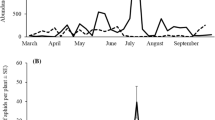Abstract
Thrips tabaci Lind. is very difficult to control and thus one of the most important pests of leek in Europe. As an alternative to insecticides biological control may be carried out by making use of beneficial insects, the Coccinellidae being one of the most important predatory families. In the present study laboratory trials were carried out withHippodamia convergens Guer.-Men., one of the polyphagous representatives of the lady birds, to figure out the feeding activity, development and prey preference ofH. convergens against the onion thrips in comparison with two aphid species.
H. convergens developed fully when fed exclusivelyT. tabaci larvae, although mortality was considerably higher and development took much longer. When fed thrips the complete development lasted 29,8 days on an average, the mortality reaching 88%. When offeredAcyrthosiphon pisum (Harris)H. convergens took only 24 days for development with a mortality of only 16%. Above all, the fourth larval instar and the pupa suffered from a very high mortality, reaching 45 and 50% respectively. WithA. pisum as a prey mortality decreased to only 6%. The duration of the pupal development was not affected by the prey species.
The feeding activity ofH. convergens increased significantly during the development. The larvae of the second and fourth instar predated 28 and 170 thrips larvae respectively per day as a maximum. The adults achieved the highest feeding activity, predating more than 300 thrips larvae in 24 hours. When adding up the number of prey individuals per day for each developmental instar, the L2 larvae predated more than 90 and the L4 larvae more than 1000 thrips larvae.
When offered thrips larvae andMyzus persicae (Sulz.) simultaneously, there was an increasing prey preference during the development ofH. convergens from first larval instar to adult. As to the last instars there was 20–25% less predation of thrips larvae compared to the aphids during 24 hours.
Similar content being viewed by others
Literatur
Drescher, K.;Schade, M.;Şengonca, Ç., 1997: Freilanduntersuchungen zur Wirksamkeit zweier Nützlinge gegenThrips tabaci Lindeman (Thys., Thripidae) im Porreeanbau. Mitt. Dtsch. Ges. Allg. Angew. Ent. (Gießen)11, 381–384.
Grevstad, F. S.;Klepatka, B. W., 1992: The influence of plant architecture on foraging efficiencies of a suite of ladybird beetles feeding on aphids. Oecologia3, 399–404.
Gutierrez, A. P.;Schultheiss, F.;Wilson, L. T.;Villacorta, A. M.;Ellis, C. K.;Baumgaertner, J. U., 1987: Energy acquisition and allocation in plants and insects: a hypothesis for the possible role of hormones in insect feeding patterns, Can. Ent.119, 109–129.
Hommes, M.;Hildenahgen, R., 1994: Thripse und Blattläuse an Kohlkopf. Neustädter Hefte66, 63–70.
Richter, E.; Hommes, M.; Krauthausen, M; Lindhorst, R., 1996: Anwendung von Bekämpfungsschwellen gegenThrips tabaci an Porree und Zwiebeln als Bestandteil des Integrierten Pflanzenschutzes. Mitt. a d. Biol. Bundesanst. Heft321.
Schade, M.;Şengonca, Ç., 1995: Einfluß zweier freigelassener Räuber auf dieThrips tabaci Lindeman (Thysanoptera, Thripidae)-Dichte an einzeln eingekäfigten Porreepflanzen im Rheinland. Mitt. Dtsch. Ges. Allg. Angew. Ent. (Gießen)10, 199–202.
Schade, M.;Şengonca, Ç, 1996: Laboruntersuchungen zur Eignung vonTyphlodromus pyri Scheuten als Räuber vonThrips tabaci Lindeman. Mitteilungen BBA (Berlin-Dahlem)321, 486.
Şengonca, Ç.; Schade, M., 1996: Feeding activity, development and reproduction ofOrius majusculus Reuter exclusively fedThrips tabaci Lindeman. Proc. XX Int. Congr. Ent., Firenze, Italy, 25.–31. 8. 1996,20/147.
Author information
Authors and Affiliations
Rights and permissions
About this article
Cite this article
Schade, M., Sengonca, C. Entwicklung, Fraßleistung und Beutepräferenz vonHippodamia convergens Guer.-Men. (Col., Coccinellidae) mitThrips tabaci Lind. (Thys., Thripidae) sowie zwei Aphidenarten als Beute. Anz. Schadlingskde., Pflanzenschutz, Umweltschutz 71, 77–80 (1998). https://doi.org/10.1007/BF02767110
Issue Date:
DOI: https://doi.org/10.1007/BF02767110




